new posts in all blogs
Viewing: Blog Posts Tagged with: Picture Books, Most Recent at Top [Help]
Results 2,901 - 2,925 of 7,833
How to use this Page
You are viewing the most recent posts tagged with the words: Picture Books in the JacketFlap blog reader. What is a tag? Think of a tag as a keyword or category label. Tags can both help you find posts on JacketFlap.com as well as provide an easy way for you to "remember" and classify posts for later recall. Try adding a tag yourself by clicking "Add a tag" below a post's header. Scroll down through the list of Recent Posts in the left column and click on a post title that sounds interesting. You can view all posts from a specific blog by clicking the Blog name in the right column, or you can click a 'More Posts from this Blog' link in any individual post.
In August, I attended the Decatur Book Festival. My favorite session by far celebrated the picture book and included author and children's book historian
Leonard Marcus, author
Laurel Snyder, author
Mac Barnett, and author/illustrator
Chris Raschka.
Here are some notes I took while listening in:
Last year, a front-page New York Times article talked about the picture book being on the way out, due to the digital revolution and ambitious parents interested in bypassing them all together.
Yet picture books still have an important place. They are a "
gateway to a life-long appreciation of art and literature" and are "an authentic meeting place for parent and child." Author Laurel Snyder believes picture books are the "
most innovative form of writing [she's] ever encountered." Mac Barnett spoke of the
"sweet spot" blend of literary and commercial literature that isn't available in any other genre.
The simplicity of the picture book is deceiving. There is a
tension between the text and image that is something bigger than the work the author and illustrator create. It is as if the two together equal more than the whole. Both adults and children make up the audience for these books, and the most effective satisfy both. There's the
"rhythm of the page turn" to consider, as illustrator Chris Raschka says.
"Your language becomes clear and true when you take words away." - Laurel Snyder
"If I've written a picture book that works without pictures, I've failed." - Mac Barnett
Book: I'll Save You Bobo!
Author: Eileen Rosenthal
Illustrator: Marc Rosenthal
Pages: 40
Age Range: 3-8

 I'll Save You Bobo! is the sequel to one of my favorite titles from 2011, I MUST Have Bobo!. The first book introduced the dynamic between young Willy, his stuffed monkey, Bobo, and Willy's cat, Earl. Willy likes to always have Bobo, his favorite comfort object, nearby. However, Earl is also attached to Bobo, and persists in dragging him away. In I'll Save You Bobo!, author/illustrator team Eileen and Marc Rosenthal continue Willy and Earl's competition for Bobo. They also introduce a new boy-friendly, imagination-focused storyline.
I'll Save You Bobo! is the sequel to one of my favorite titles from 2011, I MUST Have Bobo!. The first book introduced the dynamic between young Willy, his stuffed monkey, Bobo, and Willy's cat, Earl. Willy likes to always have Bobo, his favorite comfort object, nearby. However, Earl is also attached to Bobo, and persists in dragging him away. In I'll Save You Bobo!, author/illustrator team Eileen and Marc Rosenthal continue Willy and Earl's competition for Bobo. They also introduce a new boy-friendly, imagination-focused storyline.
I'll Save You Bobo! begins as Willy attempts to read a book about dinosaurs to Bobo. Disappointed that the dinosaur in the book isn't bloodthirsty enough, Willy decides to write his own book, about the adventures of Bobo and Willy in a snake-filled, tiger-infested jungle. Fantasy and reality collide when Earl mimics the actions of a tiger in the story, nearly ruining the book-writing. Willy concludes his jungle story in satisfying fashion by having Earl eaten by a giant snake. But it's Earl who gets the last laugh, and the last cuddle with Bobo.
This new Bobo book was an instant hit with Baby Bookworm. We easily read it ten times during our first 24 hours of ownership, and have read it at least a couple of times a day since. It's not completely clear if she likes the jungle-themed storyline or if she is just pleased to see another book about the characters (whom she loves from the previous book). But she does chortle every time at the end, when Willy is startled by Earl's tail.
I'll Save You Bobo! is a gleeful celebration of danger. The jungle that Willy draws features snakes, vines, tigers, and "giant poison mushrooms." My favorite page is one in which Willy is describing the jungle to Bobo, and then adds, in large, triumphant letters "AND WE HAVE A TENT!" It's just such a perfect five-year-old boy response, glee over the tent and over his own creativity in thinking up the tent. Later, after Willy kills off Earl (in the story within the story), he says:
"YES.
SNAKE BOOKS ARE ALWAYS GOOD, BOBO."
I'll Save You Bobo! would be a nice companion to Rocket Writes a Story, since both feature characters writing books, though the two stories are quite different in tone. Fans of I MUST Have Bobo!, particularly boys, will certainly not want to miss I'll Save You Bobo! This new Bobo book is a celebration of creativity, imaginary danger, and the companionship of a favorite stuffed animal. Highly recommended.
Publisher: Atheneum Books for Young Readers (@SimonKids)
Publication Date: April 3, 2012
Source of Book: Bought it
© 2012 by Jennifer Robinson of Jen Robinson's Book Page. All rights reserved. This site is an Amazon affiliate, and purchases made through Amazon links may result in my receiving a small commission (at no additional cost to you).
Supercalifragilisticexpialidocious does not even begin to describe the week I’ve been having! I know, I know, why should YOU care? Frankly, I don’t know. The fact that anyone other than my mother reads this blog blows my mind.
First, on Friday, my agent said she loves the 900-word picture book I just wrote. Who knew that many words was possible? I tend to stick to the 500-is-best rule, but this story was too ambitious to fit in such a tiny space. So it’s busting out into the world and I hope it writes home soon. Au revoir, dahlink!
Next, I spoke at the RUCCL One-on-One Plus conference. And people thanked me for my speech! To know that I helped a few mentees feel less nervous that day—whoa! Mission accomplished.
And now, I have an announcement!
Drum roll please….

Oh, you’re an animal, Animal!
I have an illustrator for I THOUGHT THIS WAS A BEAR BOOK (Aladdin/S&S, 2014)!
And he is full of awesome sauce! (Although he’s from the UK, so that might be called “admirable gravy” across the pond, I dunno.)
Without further ado (and I do a lot of ado), it’s…
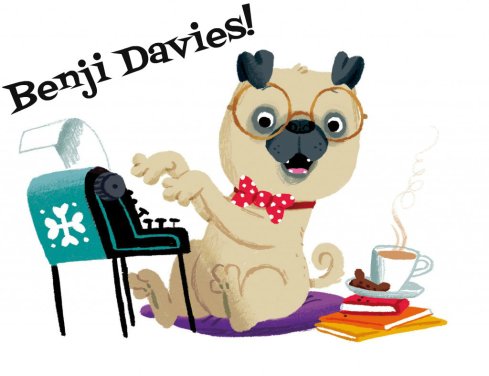
(No, that’s not Benji in the picture. Although I think that may be me on a non-showering day.)
Benji is the admirable gravy behind such books as DINO PARADE and HODGE THE HEDGEHOG (which I mistakenly thought was about John Hodgeman), plus the delightful interactive book app series from Nosy Crow, BIZZY BEAR.
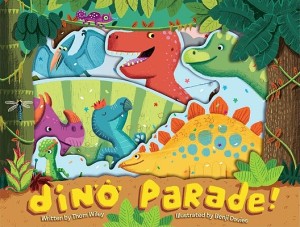
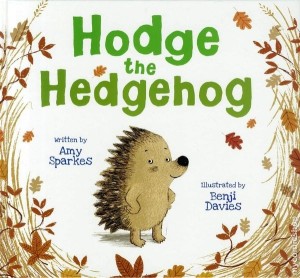
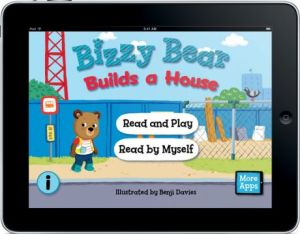
So can you tell I’m absolutely tickled to have him working on my book?
This is one of the most exciting parts of being a picture book author—finding out who your illustrator will be and falling in book love. (Not to be confused with marriage love, as I am already taken by a dashing computer geek. And yes, you can use the words “dashing” and “computer geek” in the same sentence. Although to the computer geek, it may have a programming connotation.)
So check out Benji’s work, congratulate him, and also give him fair warning that he’s working with an absolute nut. He may require counseling after the book launch.
After all, I called him “admirable gravy”!


Aaron and I read to Elliott every night before bedtime (and lots during the day too, of course). Lately, I've been reading to him in the bathtub, to keep myself entertained while he's splashing around with his toys. We read our
first chapter book that way!
We've moved onto a new book to read together: The Family Bedtime Treasury. Though we're all book lovers in this house (though sometimes Aaron has to be convinced he's a book lover) we have very limited shelf space in each room to hold all the books we love, so fitting 16 awesome bedtime stories into one volume works really well for us.
Included are some of my all-time favorites: The Napping House, Gideon, and No Sleep for the Sheep, along with several new-to-us stories and poems. The variety is fantastic. It also comes with a cd filled with an hour of classical music. We were able to download it for free, since we don't really have anything to play a cd, which was a really nice option. We've listened to the music during our last feeding of the night and it's very soothing.
The Family Bedtime Treasury would make a great gift for a birthday or a unique shower gift. I'm always looking for those! It's nice to include other siblings in gifts like those and this has something for everyone.
The Family Bedtime Treasury: Tales for Sleepy Times and Sweet Dreams276 pagesHoughton Mifflin Harcourt9780547857862September 2012Review copy
Ralph Tells a Story written and illustrated by Abby Hanlon (Amazon Children’s Publishing, 2012). It doesn’t matter if your five or twenty-five—if you’re in school, you’re gonna have to write. And lots of times you have to write stories—stories about yourself. Maybe it’s a daily journal. Maybe it’s a “My Special Moment” essay. Maybe it’s a descriptive narrative for a college composition class. Well, if you’re one of those kids who has NO IDEA what to write about and can’t think of ONE SINGLE STORY, then Abby Hanlon’s Ralph Tells a Story is the book for you. Ralph’s teacher always says, “Stories are everywhere!” and the kids in Ralph’s class have no trouble finding them. They write pages and pages and pages during writing time. But Ralph can’t come up with anything. Zero, zip, nada. So Ralph does what all smart kids do. He stalls. He goes to the bathroom. He gets a drink. He offers to help the lunch ladies. And finally, finally, Ralph thinks of the start of a story. But then he gets stuck. Which is exactly when his teacher asks him to share his story. Luckily for Ralph, his classmates ask lots and lots of questions. [...]

By: Brimful Curiosities,
on 10/12/2012
Blog:
Brimful Curiosities
(
Login to Add to MyJacketFlap)
JacketFlap tags:
Friendship,
Book Review,
Picture Books,
Toys,
Random House,
robot,
2012,
Imaginative Play,
Alfred A. Knopf,
Book crafts,
Add a tag
I've traipsed through many a wood and have collected my share of pinecones, but never, never on any of my adventures have I come across a friendly, mechanized, working robot. I must be walking through the wrong kind of woods, because in Ame Dyckman's picture book world this scenario is entirely possible.
Simply and perfectly told with bold, eye-pleasing illustrations by robot-lover Dan Yaccarino,
BOY + BOT
is quite possibly the best robot picture book we've ever read (and believe me, we've read several). The story-line goes like this: Boy walks through the woods. Boy meets a big, red robot. Boy and robot problem-solve. Robot and boy become BFF. Now obviously there's more to it than that, like for instance both boy and bot have similar "misunderstood malfunctions" and need fixing, but to say any more would spoil the fun. Read the robot parts aloud in your best robot voice. Remark on all the fun things the robot and boy do together like swimming, apple-picking and rock-skipping. And remember, little boys do not need oiling, and never, ever feed your robot applesauce.
This book deservedly received starred review from Kirkus, Booklist, and Publishers Weekly. Take our word for it (and theirs), if you have a young, robot-loving child,
BOY + BOT is for them and worth purchasing.
Fun fact:
If you look closely at the illustrations in BOY + BOT you'll discover one of Yaccarino's creative additions to the story -- a light-bulb shaped, one-eyed robot that Ame Dyckman calls "Watt." Not surprisingly, illustrator Dan Yaccarino has a self-described "
slight penchant for robots." He is also the author/illustrator of another robot picture book,
If I Had a Robot
, a story about a boy who dreams about all the things he could or wouldn't have to do if he had a robot. His robot illustrations have a retro, vintage look reminiscent of those tin
wind-up robot toys from the past. Related links: Ame Dyckman - Author Website Dan Yaccarino - Illustrator Website BOY + BOT by Ame Dyckman, illustrated by Dan Yaccarino. Alfred A. Knopf / Random House (April 2012); ISBN 9780375867569; 32 pages
by Ame Dyckman, illustrated by Dan Yaccarino. Alfred A. Knopf / Random House (April 2012); ISBN 9780375867569; 32 pages
Book Source: copy from our personal library
Sadly we have not discovered our own robot friend in the woods, so my son and I did the next best thing ... made our own robot out of LEGOs. Our LEGO collection is large and diverse enough to provide ample parts for robot building. We have eyes, connecting parts to make arms that swing and plenty of multi-sized, red blocks.
My son insisted that our BOT robot have a power switch in the back. Pair the LEGO bot with a boy mini-figure and let the book play-acting begin!
'"What's wrong?" the boy asked. The robot did not answer.
"Are you sick?" the boy asked. The robot still did not answer.
"I must help him," the boy said."'
I am an Amazon affiliate and may receive a very small commission for products purchased through my Amazon links. (View my full disclosure statement for more information about my reviews.)
Halloween will be here in just two-and-a-half weeks. What a good time to start reading some spooky stuff. Below are two brand new scary tales.
THE BOO! BOOK by Nathaniel Lachenmeyer is a new picture book adventure, complete with its own ghost right inside the book. Do you dare to read it???
TEN CREEPY MONSTERS by Carey F. Armstrong-Ellis delivers a bookful of monsters and mystery on a Halloween quest for treats.
Check out the list on my website for a bagful of other great spine-tingling reads: FRIGHTFUL READS FOR KIDS

By: Molly,
on 10/11/2012
Blog:
the pageturn
(
Login to Add to MyJacketFlap)
JacketFlap tags:
YA,
kidlit,
Books,
Authors,
Picture Books,
librarians,
middle grade,
tween,
YA Books,
preview,
Tween books,
Add a tag
Our NYC-area librarian pals were kind enough to join us last week for an early morning of ferocious book talking, coffee consuming, and oohing and aahing over our upcoming Winter (and early Summer) 2013 titles. It was an oddly hot and humid day to chat about Winter (10 weeks until Christmas…it’s really coming!), but we managed to get into the spirit and of course, had an absolutely lovely time.
A few snapshots:

Balzer + Bray VP and Co-Publisher, Alessandra Balzer, holding ELVIS AND THE UNDERDOGS, by Jenny Lee, and THAT IS NOT A GOOD IDEA! by Mo Willems.

Editorial Director Tara Weikum with CITY OF A THOUSAND DOLLS by Miriam Forster, and Executive Editor Erica Sussman with THE MENAGERIE by Tui Sutherland and Kari Sutherland, and MIND GAMES by Kiersten White.

Greenwillow editor Martha Mihalick with the stunning and creepy cover for ARCLIGHT, by Josin L. McQuein.
Our editors have truly outdone themselves with this season’s crop of really terrific “This Meets That” book descriptions… :
Lo and behold, a new Preview blog post feature! These are books that, when mentioned, garnered an across-the-room-audible “awwwww!” from the audience:
- AMELIA BEDELIA– 2013 is the 50th Anniversary of our favorite mixed-up but wholeheartedly well-meaning friend Amelia! We’re reissuing the original picture book in a bit larger trim size with truly fantastic additional back matter.
- TIPTOE JOE, by Ginger Fogelsong Gibson, illustrations by Laura Rankin — I won’t spoil the payoff of this adorable picture book, but let me just say, you’ll lay your hand over your heart when you get to the end.
- GIANT DANCE PARTY– written by THE Betsy Bird! Illustrations by Brandon Dorman.
- RAMONA– We’re repackaging the entire beloved Ramona series in 2013, and let me tell you, the art is adorable. The consensus in the room (and from Beverly Cleary herself, of course) was that this is true Ramona- goofy, a bit scruffy, and every bit lovable.
And that, my friends, is the inside scoop!
Book: Because You Are My Teacher
Author: Sherry North
Illustrated: Marcellus Hall
Pages: 32
Age Range: 4 - 8

 Because You Are My Teacher is the latest book from Sherry North and Marcellus Hall, the team that wrote and illustrated Because You Are My Baby and Because I Am Your Daddy. It's a book that I think is better than the title promises. Really, I almost didn't even open this one, because I thought that it would just be a sentimental book written to please teachers, rather than a book to please kids. While I adore and admire teachers, the picture books that I'm looking for are the ones that will keep kids turning the pages. But I have to say that this book is more kid-friendly than the title would suggest.
Because You Are My Teacher is the latest book from Sherry North and Marcellus Hall, the team that wrote and illustrated Because You Are My Baby and Because I Am Your Daddy. It's a book that I think is better than the title promises. Really, I almost didn't even open this one, because I thought that it would just be a sentimental book written to please teachers, rather than a book to please kids. While I adore and admire teachers, the picture books that I'm looking for are the ones that will keep kids turning the pages. But I have to say that this book is more kid-friendly than the title would suggest.
Each page spread features a teacher and her four students visiting a different part of the world (or, in one case, outer space). Each two-line couplet manages to get in a fact or two about the location, while also introducing a different mode of transportation. Like this:
"If we had a schooner, we would have our class at sea
And study the Atlantic, where the great blue whales roam free."
and:
"If we had a river raft, we would tour the Amazon
And listen as the howler monkeys growl their spooky song."
There's no narrative arc. Just a series of these visits. But some of the scenarios are quite kid-friendly, as when they use hang gliders to get "a bird's-eye view" of a giant kangaroo. Then the book ends with:
"Our classroom is our vessel,
always headed someplace new.
Because you are our teacher,
We'll explore the world with you."
I can't say I was wowed by the ending. But I did very much like Marcellus Hall's watercolor illustrations. The teacher (of some brown-skinned, black-haired ethnicity) is smiling and intrepid. The four children are wide-eyed and interested in everything. The various animals that they encounter are slightly cartoonized (in a good way), with big eyes and expressive faces. I especially liked the alligators from the Everglades and the elephants from Africa. Each page has its own color palette, reflecting the landscape. There's also a lot of action conveyed in the pictures (see the page where the class goes kayaking in the Grand Canyon, for example). They are pictures that I would be happy to visit again and again.
So, while I think that the storyline is a bit contrived (perhaps designed to fit in with the rest of the series), I still found Because You Are My Teacher to be a kid-friendly book. There's plenty of action, all of it in interesting settings. There's a fair bit to be learned from the book, without it feeling dry or didactic. And the illustrations are eye-catching and full of likeable characters. This would certainly make a good gift book for a beloved teacher. But I hope that it also finds its way into the hands of kids. Because You Are My Teacher is a fun ride.
Publisher: Abrams (@ABRAMSbooks)
Publication Date: August 1, 2012
Source of Book: Review copy from the publisher
© 2012 by Jennifer Robinson of Jen Robinson's Book Page. All rights reserved. This site is an Amazon affiliate, and purchases made through Amazon links may result in my receiving a small commission (at no additional cost to you).

By:
Debbie Ridpath Ohi,
on 10/11/2012
Blog:
Inkygirl: Daily Diversions For Writers
(
Login to Add to MyJacketFlap)
JacketFlap tags:
Promotion & Marketing,
halloween,
Picture books,
Videos,
Inspiration,
craft,
promotion,
pumpkin,
Random Diversions,
Add a tag
Wow, check out the amazing kidlit-focused pumpkin carved by children's book author/illustrator David LaRochelle:

From David:
"Chronicle Books held a promotion in conjuncture with my new book "It's a Tiger!" The winning bookstore won a custom designed pumpkin carved by me. Here is the pumpkin I carved today for Riverwalk Books in Chelan, Washington."
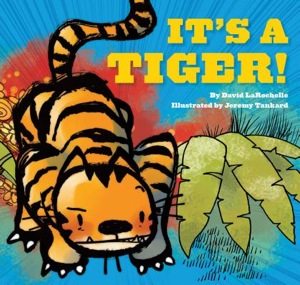
See a video of David carving pumpkins:
Pro-Pumpkiner from Ben Garvin on Vimeo.
Book: I Want to Help!
Author: Diane Adams
Illustrator: Nancy Hayashi
Pages: 32
Age Range: 4-8

 I Want to Help!, written by Diane Adams and illustrated by Nancy Hayashi, is about the abilities of and challenges faced by preschoolers (or perhaps kindergartners). Emily Pearl is a highly energetic young girl, able to beat the boys in a race, count to 14, and take the monkey bars two at a time. Throughout the day, she constantly tries to help her long-suffering teacher (with mixed success). When her father is late to pick up her, Emily's teacher, Ms. Glenn, uses Emily's desire to help to distract her from worrying.
I Want to Help!, written by Diane Adams and illustrated by Nancy Hayashi, is about the abilities of and challenges faced by preschoolers (or perhaps kindergartners). Emily Pearl is a highly energetic young girl, able to beat the boys in a race, count to 14, and take the monkey bars two at a time. Throughout the day, she constantly tries to help her long-suffering teacher (with mixed success). When her father is late to pick up her, Emily's teacher, Ms. Glenn, uses Emily's desire to help to distract her from worrying.
I personally found the story itself to be lacking in narrative punch. It's more like a series of vignettes throughout the day, capped off by the incident, over just a couple of pages, about the late father. Yes, Emily spends the day trying to help, and does end up being asked to help in the end, but it's not because the teacher actually needs her. And all of her offers to help throughout the day are intermixed with general statements about what Emily is like "strong", "brave", etc. It just doesn't hold together for me as a narrative.
And yet, I still find it an enjoyable read (and I've read it quite a few times, because my two-year-old loves it). The text is catchy. The refrain stays stuck in my head for days after a read. Mostly this part:
"And whenever Ms. Glenn
sighs, "Oh, my," to herself,
Emily Pearl says,
"I want to help!""
But the rest of the text reads aloud well, too. Like this (over several pages):
"Emily Pearl is a very brave girl.
She can give the tarantula water and bugs.
She can let out the rabbit and clean up the rug.
She can shoo away critters
that come to the door.
And capture the crickets that hop on the floor."
I think that what Baby Bookworm likes is the glimpse of life in a classroom. Most of the humor goes right over head, but the bits that she does get, she thinks are hilarious.
A lot of the humor in I Want to Help! comes from Hayashi's watercolor, pen, and colored pencil illustrations. She shows how things "really" are. For example, at one point the text says :
"Emily Pearl is a very big girl.
She can wash her own paint can
and put it away."
The picture shows Emily rinsing out her paint can in the water fountain, with colored water spilling all over the floor, and Ms. Glenn looking on. Emily's classmates are frequently shown either laughing at her antics (as in the paint can example), or getting knocked over by Emily's careless exuberance (like when she takes the monkey bars two at a time). I think that kids who mean well, but struggle to sit still, or put things away properly, will identify with the pictures of Emily Pearl.
The classroom setting is cheerful, full of crayons and books, pets and projects. There are huge windows, and an old-fashioned, minimalist playground. The combination of day-to-day activities shared in the text and the kid-friendly classroom make this a good book to read with kids who are about to start school. I Want to Help! is a book that will allay fears, and increase enthusiasm about going to school. And it just might make kids want to help out more, too.
Publisher: Peachtree Publishers (@PeachtreePub)
Publication Date: September 1, 2012
Source of Book: Review copy from the publisher
© 2012 by Jennifer Robinson of Jen Robinson's Book Page. All rights reserved. This site is an Amazon affiliate, and purchases made through Amazon links may result in my receiving a small commission (at no additional cost to you).

Creepy
Carrots by Aaron Reynolds. Illustrated by Peter Brown
Marirosa Mia:
Jasper Rabbit LOVES carrots. He loves them like I love Nutella, which is a lot,
people. He plucks them from Crackenhopper Field on the way to school, a game,
or back home. Then one day Jasper is sure that his favorite treat is following
him. He sees creepy carrots in his bedroom! Creepy carrots following him to
school! It's driving him mad. Is Jasper's favorite snack actually following him
around, or has he had one (something or other) too many? Written by Aaron
Reynolds and illustrated by the talented Peter Brown (author and illustrator of
THE CURIOUS GARDEN), CREEPY CARROTS is a fun tale of paranoia and a possible
Vitamin A overdose resulting in visual hallucinations. Kidding! I found
CREEPY CARROTS to be a zany trip to the twilight zone, cleverly illustrated
with a funny (and slightly morbid) twist ending. Julie?
Julie: I
love the combination of humor and horror in this book. The art is
simultaneously ominous--almost exclusively black and white with splashes of
orange (primarily the carrots); plenty of shadows; a Hitchcock-ian shower
scene; sinister sightings in the tool shed--and hilarious. We're
talking, after all, about carrots! With crossed eyes and occasionally severed
heads (why severed? I don't know!) and gaps in their teeth. The overall
effect is both unusual and riveting. I predict kids will love it. Do you agree,
Mia?
M: Yes! Huge
fan of the art. I think this was a great pairing of minds, and the nod to
Hitchcock and that era is spot on. I can't wait to read it to my niece, who
loves carrots (by which I mean she eats them without complaint). Our readers
should also check out this lovely video of Peter Brown talking about why he
chose this particular style for CREEPY CARROTS.

J: Is
there something you didn't love about the book? I have to confess that although
I credit the cleverness of the ending, I don't love it. I don't want to give
anything away--I'll just say that it felt very concrete and confining to me, in
a way that seems at odds with the free-wheeling imagination of the story. Does
that make any sense at all?
M: Do you
mean you saw the ending coming? I'm not sure I understand.
J: No, that's
not what I mean. I've been trying fruitlessly to think of a way to
explain that doesn't ruin the ending. So, SPOILER ALERT!!! Do Not Read Further
If You Want to Keep the Ending a Surprise! Last chance to look away. Okay, here
goes: I guess I love the notion that these wacky carrots are roaming around out
there, popping up in surprising places, making funny faces. Having them all
hemmed in at the end--even though they're happy in their confinement--brought
an abrupt halt to my carrots-on-the-loose imaginings. I frankly felt a little
irritated!
M: Ah, I see.
You weren't fond of the gated community and you like your carrots free-range.
J:
Exactly! Is that so wrong?
M: Not at all, Julie, not at all.
For two years I’ve been Tweeting the hashtag #bedtimepicks to share the picture books I’m reading to my kids that night. For two years some folks have joined in, yet all have dropped out.
Then I realized: YOU HAVEN’T BLOGGED ABOUT THIS FOR TWO YEARS?
What is wrong with me? (Don’t answer that!)
So I now triumphantly propose we get moving with this hashtag! It’s a simple way to share and discover great picture books. (And if you read chapter books or middle grade novels to your kids, of course, those count, too!)
In the evening, tweet something like this:

 Then click on the hashtag to see what other parents and caregivers are reading.
Then click on the hashtag to see what other parents and caregivers are reading.
VOILA!
TWO YEARS IN THE MAKING!
If you’re in, let me know in the comments. And please blog about it to spread the word.
Now quick, let’s all play catch-up!


Harmony asked:
I have a question which you may have written about somewhere… but anyway, I have a just-turning-3 boy. We’ve enjoyed a lot of the picture books you’ve recommended, but I think he may be getting ready for some longer books. I’m curious what chapter books have gotten your kids interested at early ages? Not to replace beautiful picture books of course! Just in addition. I’m thinking to try Winnie the Pooh… other ideas?
I guess I have two questions, because another thing I’ve wondered about is early readers. I think my son would love Frog and Toad, and Elephant and Piggie–but should I save those for when he can actually start to read them himself? Have you ever struggled with this?
These are great questions. I’ll start with the second batch first: nope, I’ve never saved beginning readers for actually-beginning-to-read children because—well, at first it was probably because I couldn’t wait to share those stories, but also it’s because beginning readers make such wonderful read-alouds for toddlers. It’s funny, though, now that you’ve made me consider the question, Harmony: I don’t think I’ve ever seen much discussion on this topic. But here’s what I think—wait, to get there, first I have to back up to picture books.
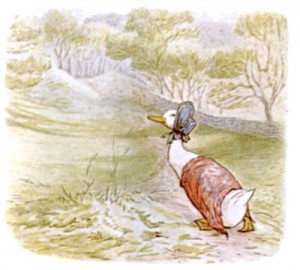 Picture books are written to be read by an adult to a child. The vocabulary is often quite sophisticated—think of Beatrix Potter: “Jemima Puddle-duck became quite desperate. She determined to make a nest right away from the farm.” Many contemporary picture books are tending toward simple, spare text (many of them quite wonderfully, like I Want My Hat Back or the charming Me Hungry); but in my mind the form is dominated by longish stories with rich vocabulary.
Picture books are written to be read by an adult to a child. The vocabulary is often quite sophisticated—think of Beatrix Potter: “Jemima Puddle-duck became quite desperate. She determined to make a nest right away from the farm.” Many contemporary picture books are tending toward simple, spare text (many of them quite wonderfully, like I Want My Hat Back or the charming Me Hungry); but in my mind the form is dominated by longish stories with rich vocabulary.
(To run off on a tangent: I’ve known parents who steered their children away from picture books once the kids learned to read, or hit first grade. Too young, not challenging enough, etc. Au contraire, I say! Picture book text is often MUCH more challenging for an emergent reader than the Early Reader books, about which more in a second. Besides, no one, not anyone, is ever too old for a good picture book. I mean it. All the Places to Love or I Remember Papa can be every bit as moving and cathartic a read for an adult as Persuasion. The Quiltmaker’s Gift is better therapy than Pinterest. I get the same uplifted, happy rush from Mordant’s Wish as I do from About a Boy.)
I’ve had toddlers who liked to cuddle up and listen to long picture books (especially Jane, who spent nearly a year of her toddlerhood in a hospital bed—sitting and listening was one of a very limited range of options, in her case) and toddlers for whom the concept of sitting in one place for a 32-page stretch was a notion for another universe. (Hello, darling Bean.)  For those children especially, but really for all my two- and three-year-olds, I drew (draw, since Huck is this age exactly) heavily on treasured Early Reader favorites like Little Bear, Frog and Toad, The Best Nest, Newt, Biscuit, Mouse Soup, Owl at Home—oh, anything by Arnold Lobel really. And yes, yes, yes, absolutely Elephant and Piggie. We’ve had stretches these past few years where I bet I read five or six Elephant and Piggie books a day—five or six times each! Both Wonderboy and Rilla made giant leaps toward reading thanks to Mo Willems and his animal antics.
For those children especially, but really for all my two- and three-year-olds, I drew (draw, since Huck is this age exactly) heavily on treasured Early Reader favorites like Little Bear, Frog and Toad, The Best Nest, Newt, Biscuit, Mouse Soup, Owl at Home—oh, anything by Arnold Lobel really. And yes, yes, yes, absolutely Elephant and Piggie. We’ve had stretches these past few years where I bet I read five or six Elephant and Piggie books a day—five or six times each! Both Wonderboy and Rilla made giant leaps toward reading thanks to Mo Willems and his animal antics.
 I also had the fun of trying out both my Inch and Roly series and Fox and Crow Are Not Friends on my ready-made test audience here at home. I read my littles the manuscripts straight off the computer. It’s always helpful to read your work aloud, but when you’re writing an early reader or picture book, it’s imperative: if I’m going to inflict a book upon a parent who may, if I’m lucky, be called upon to read the book over and over and over, I’ve got to do my best to make sure that isn’t a torturous experience. And not just that. Reading a manuscript aloud always alerts you to clunky bits that need more polish. And children, even (especially?) your own children, will inform you with unabashed clarity where you’ve lost their attention. My early reader manuscripts are much tighter after a round or two of read-alouds to Huck and Rilla. When they start asking for ‘that story’ again—’you know, Mommy, that book on your computer’—then I know I’m on the right track.
I also had the fun of trying out both my Inch and Roly series and Fox and Crow Are Not Friends on my ready-made test audience here at home. I read my littles the manuscripts straight off the computer. It’s always helpful to read your work aloud, but when you’re writing an early reader or picture book, it’s imperative: if I’m going to inflict a book upon a parent who may, if I’m lucky, be called upon to read the book over and over and over, I’ve got to do my best to make sure that isn’t a torturous experience. And not just that. Reading a manuscript aloud always alerts you to clunky bits that need more polish. And children, even (especially?) your own children, will inform you with unabashed clarity where you’ve lost their attention. My early reader manuscripts are much tighter after a round or two of read-alouds to Huck and Rilla. When they start asking for ‘that story’ again—’you know, Mommy, that book on your computer’—then I know I’m on the right track.
Anyway, to return to the question: by all means, add Early Readers to the toddler’s shelf. 
As for the first question, about longer-form read-alouds for three-year-olds, we usually do Pooh around age four (though Rilla didn’t cotton to it at that age; nor did Wonderboy), and we nearly always read the My Father’s Dragon series as our first novels. I have a list of other good read-alouds for four-year-olds here. I remember reading The Lion, the Witch, and the Wardrobe to Jane at age four, and Rose’s obsession at that age (and long afterward) was anything to do with Greek myths, but Rilla (at age six) still MUCH prefers picture books and Early Readers over anything that looks like a novel. She eyed Brambly Hedge with suspicion at first, because of its size (we have the large Treasury edition that includes all the books), but its profusion of pictures won her over. She also loved The Cottage by Bantry Bay and The Family Under the Bridge. But now it’s back to ‘Too long, not enough pictures, I only like picture books.’ Which is fine with me. Our picture-book collection occupies a formidable amount of square footage in this little house; it’s got to earn its keep. 
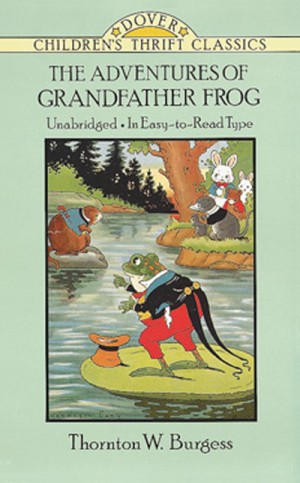 Besides the list of short novels and story collections I linked to above, let me throw in a vote for Thornton Burgess’s various animal stories (available in inexpensive Dover editions). Also the Family Treasury of Little Golden Books: obviously, those are picture books, not novels, but the older Golden Books tend to be quite text-rich. Any good collection of folk or fairy tales is an excellent choice for three- and four-year-olds (though don’t be surprised if most fairy tales turn out to be too long for a three-year-old to hear in one sitting; that goes for any longer-form prose story, really). Just So Stories—delicious—already on my other list, I think.
Besides the list of short novels and story collections I linked to above, let me throw in a vote for Thornton Burgess’s various animal stories (available in inexpensive Dover editions). Also the Family Treasury of Little Golden Books: obviously, those are picture books, not novels, but the older Golden Books tend to be quite text-rich. Any good collection of folk or fairy tales is an excellent choice for three- and four-year-olds (though don’t be surprised if most fairy tales turn out to be too long for a three-year-old to hear in one sitting; that goes for any longer-form prose story, really). Just So Stories—delicious—already on my other list, I think.
As I list all these suggestions, I’m aware that Huck (who will be four in January) is not ready for many of them. Too much text for his busy, bouncy body. I could woo him with Just So Stories, I think (note to self: give it a try) and the Little Golden Books, but he wandered off quickly when I was reading a Burgess story to Rilla the other day. What he wants, over and over and over and whyyyy did we succumb to the request?, is a Thomas the Tank Engine 8×8 we picked up after my booksigning last week. I am Beezus, he is Ramona, and this book is our Scoopy.
(I guarantee you no one involved in the publication of this Thomas book read it out loud even once, much less six times a day, every day for a week. I’m just saying.)
I might have mentioned this before, but in a former life, I was a drama major. Perhaps this is why I think of picture books as "performance pieces." After all, picture books are meant to be read aloud.
Jill started off this topic with her discussion of rhythm and rhyming picture books. Jill is a far braver soul than I. I have published six picture books (with another on the way) and none of them rhyme. My brain doesn't work that way.
This is not to say that my stories don't have rhythm. They do. Jill covered this pretty well in her last post so I won't belabor the point here. I'll just say that if you aren't sure if your story has that "swing," read it out loud. Better still, have a non-judgemental friend read it to you. If you find yourself stumbling over your own words, or if your friend's voice hits a word that sounds like an out-of-tune piano key, go back to Jill's post.
So if I don't rhyme, how do I (hopefully) hold my listener's interest?
Repetition, for one thing. There's nothing like a little group participation, whether you are reading to one child or seventy. If you want a good example of that, check out my First Grade Stinks. The title is also the main character's catch phrase whenever she is frustrated by yet another unfamiliar aspect of a new grade and teacher. After awhile, the listener will chime in as well. (Loudly.)
I love to play around with words. I'm a big believer in alliteration. In Camp K-9, Roxie goes to camp with a Pooch Pouch and makes friends with Pearl the Pug. A word of caution. Be spare with the mirroring consonants. When my daughter was small, there was one particular picture book (no titles mentioned here) that her father and I tried to hide at storytime. Why? Seemingly every word in this book began with the letter "p." It was not a short book either. Two pages into it and my husband and I were sputtering and stuttering like Porky and Petunia Pig. Sometimes, we got so flusterated that certain expletives (not written by the author) slipped into the narrative. Not good. Not good at all.
My favorite writing technique (in novels as well as picture books), is the use of sounds. (There is a polysyllabic word for this that I can't spell, and I am using a computer that doesn't have autocorrect.) The stories I remember from my own childhood were actually songs, like "Old MacDonald Had. a Farm" and "The Wheels on the Bus." When I began writing my own stories, without really thinking about it, a "moo moo" here and a "cluck cluck" there showed up on my pages.. Sounds are fun to write, fun to read and gives the listener another opportunity to "read along." (The only one who doesn't enjoy my "sound technique" is the copy editor who sends me notes questioning the correct spelling of "va-va-varoom.")
If you want to see me go crazy with the sound effects, check out Surprise Soup. In fact, when I was writing it, I began by listing all the kitchen sounds I could thing of. Here is a partial list: chippity-chop (a knife), ka-rickety-ritch (a manual can opener), splishety-sploosh, slippety-slop,
shakety-shake (ingredients going into the soup pot.) Once I had a list of thirty-something sounds, the story wrote itself.
A successful picture book is one that a child wants to hear over and over (and that the reader can read over and over without wanting to rip out his/her hair.) I think playful language is the grace note that adds zip and zing to "Jill's swing," and a little fun for the adult reader as well.
Don't forget that the deadline for our latest book giveaway Forget Me Not by Carolee Dean is this Thursday, Oct. 11. Good luck!
Posted by Mary Ann Rodman

Although books are initially a visual experience, they become an auditory encounter as well when read aloud. So what better way to help introduce young readers to the wonders of music than through well crafted picture books on music. The illustrations combined with the sound sensations of the words create a fun and enlightening experience.
Here are some gems to share with your little ones:
M Is for Music by Kathleen Krull. This alphabet book is a great introduction to musical terms and composers.
Ah, Music! by Aliki. Another introductory book, this one combines lovely illustrations with explanations of musical concepts, including pitch, rhythm, tone, as well as information on conductors, instruments and the history of music.
I Know a Shy Fellow Who Swallowed a Cello by Barbara Garriel. A silly story of a young man who swallows a cello, saxophone, fiddle, kazoo, harp, and a bell. When he belches out the instruments, they emerge with their accompanying sounds.
The Jazz Fly by Matthew Gollub. A fly jazzes up animal sounds to create a hit.
Jazz Baby by Lisa Wheeler. A fun read-aloud that celebrates the sound of jazz.

And one of my grandson and my favorites right now is
Baby Danced the Polka by Karen Beaumont. Mom, Dad, and baby can't resist the beat of a polka tune in this colorful picture book. I found a board book edition with fold-outs that make this story interactive for even a one-year-old. And, or course, we (Grammy and Sammy) can't resist dancing the polka as well.
By:
KidLitReviews,
on 10/7/2012
Blog:
Kid Lit Reviews
(
Login to Add to MyJacketFlap)
JacketFlap tags:
middle grade books,
5stars,
Library Donated Books,
paul b janeczko,
children's books,
Poetry,
picture books,
Middle Grade,
humor,
Candlewick Press,
Add a tag
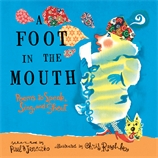 5 Stars
A Foot in the Mouth:
Poems to Speak, Sing, and Shout
Paul B. Janeczko
Candlewick Press
No. Pages: 64 Ages: 8 to 12
........................
................
5 Stars
A Foot in the Mouth:
Poems to Speak, Sing, and Shout
Paul B. Janeczko
Candlewick Press
No. Pages: 64 Ages: 8 to 12
........................
................
From the Introduction: Poetry is sound. Oh, sure, it’s other things too, but sound needs to be near the top of the list. To hear the sound of a poem, really hear it, you need to read it out loud. Or have someone read it to you. All the poems in this book have been chosen because they are terrific candidates for reading aloud. They might be as easy as the six-word “Gigi” by Arnold Spilka, or as “frabjous” and as “brillig” as Lewis Carroll’s “Jabberwocky,” full of delicious nonsense words to roll across your tongue. Many of the poems have very strong rhyme schemes—the poet is showing you how to read the poem through the use of rhyme.
You don’t need to be an expert, and if you’re not sure how a certain part should sound, ask a parent or teacher. Practice a few times. In no time at all, you’ll be able to share the music of a good poem read aloud. If you’ve never read a poem to somebody, you don’t know what you’re missing. This book will give you a chance to change that. These three dozen poems are especially satisfying spoken, recited—shouted!—out loud, from lively rhymes to tricky tongue twisters. Give it a try – Paul B. Janeczko
A Foot in the Mouth is a wonderful collection of some of the silliest, funniest, sarcastic, and fabulous poems for children I have ever read. Adults who like revisiting their child-self through books will enjoy reading this diverse selection of poetry. There are tongue twisters, limericks, rhymed poems, bilingual poems, and poems for one voice to a group of voices. Poets include A.A. Milne, Walt Whitman, William Shakespeare, and a few who did not want to, like to, or forgot to, take credit for their work.
I really enjoyed reading, and reading again, these poems, which are mostly humorous. I like funny. I also like the occasional quirky, such as Old Hank by an unknown poet, penning under the pseudonym Anonymous. Okay, okay. No one can recall who wrote Old Hank, still I like it for its irony.
..............................For a lark,
..............................For a prank,
..............................Old Hank,
..............................Walked a plank.
..............................These bubbles mark
.....................................O
.....................................O
.....................................O
.....................................O
.....................................O
..............................Where Hank sank.
.....................
Oh, poor Old Hank, walked that plank, trying to prank someone and instead of bobbing back to the surface and yelling “Gotcha,” he sank and stuck. Old Hank is but one of the shorter poems that try to say much with few words. As a kid, I loved limericks and devoured all the limerick books at the library. I like the identical cadence and the often-unexpected wit about them. There are only three limericks in A Foot in the Mouth, yet kids will get the structure of these poems quickly.
 The illustrations cannot be overlooked. They enhance each poem, sometimes help explain the poem, but mostly entertain alongside them. Most of the illustrations look abstract. I am not a graphic artist by any stretch of my imagination, so let me try to explain.
The illustrations cannot be overlooked. They enhance each poem, sometimes help explain the poem, but mostly entertain alongside them. Most of the illustrations look abstract. I am not a graphic artist by any stretch of my imagination, so let me try to explain.
People, animals, and things are comprised of a stroke of paint pulled, blotched, spotted, or sprayed on to make the object. Patterns instead of sketched/painted lines make up these picture.*
I like them, think they are fun and often funny. The illustrations fill up the white space on many of the pages and give the eye a second enjoyable piece of art to consume.
Poetry for children does not show up in my mailbox often, but when it has, the results have been fantastic. This book does not disappoint. The humor and fun in each of these poems, regardless the form, will delight those that read them. When delighted, we want more. That is my wish for A Foot in the Mouth—that kids will be so delighted with these poems they will seek out others.
*If anyone can explain this better, please do so in the comment section. Thank you.
Foot in mouth
Author: Paul B. Janeczko website bio
Illustrator: Chris Raschka bio
Publisher: Candlewick Press website
Release Date: March 10, 2009
ISBN: 978-0-7636-6083-3
Number of Pages: 64?
Ages: 8 to 12
................

Filed under:
5stars,
Library Donated Books,
Middle Grade,
Poetry Tagged:
Candlewick Press,
children's books,
humor,
middle grade books,
paul b janeczko,
picture books,
poetry 






 Ibrahima Ndiaye, illustrated by Capucine Mazille, translated by Rebecca Page,
Ibrahima Ndiaye, illustrated by Capucine Mazille, translated by Rebecca Page,
The Magic Formula
Bakame Editions (Rwanda), 2011.
The Magic Formula is a retelling of an African folktale about a magic marula tree that won’t release its fruit until a certain long, complicated phrase is recited. Set during a drought in the land of “Farafinaland” in the year “nobody-knows”, the animals have all come together in their suffering. Nevertheless, their individual traits emerge in the course of the lively narrative: the lion is fierce; the hyena is sneering and excitable; and the elephant is wise.
One day, the elephant calls on the animals to journey together in search of food (also offering scope for the eye-catching illustration both within the story and spread across the book’s covers). The insects provide an “aerial escort”, and the chameleon with his “special eyes” takes on the role of scout perched on the giraffe’s head. Sure enough, he is the first to see the magic marula tree laden with fruit – and he also spots the old woman Mama Tenga under another distant tree. She gives the magic words to first the elephant and then the hyena – but each is distracted on the way back to the marula tree and forgets them. It is only when, at the elephant’s suggestion, they all work together in “solidarity” that they are able to remember the words and access the fruit.
Ibrahima Ndiaye’s retelling is slightly different from another recent version of the story from Tanzania, The Amazing Tree (North-South Books, 2009) by John Kilaka, whose work has also been published by Bakame Editions. These two versions compliment each other with their different sets of characters and the chant in Kinyarwanda in The Magic Formula and in Kiswahili in The Amazing Tree, as well as the contrasting styles of the illustrations. Here, Capucine Mazille’s watercolours add depth to the story with a wonderful mix of charaterful facial expressions. As well as the key characters, the line-up includes an exciting array of different African animals, including an aardvark and a pangolin – plenty to absorb young readers. The lively dialogue also makes this a great readaloud, and young listeners will probably soon pick up the magic formula quicker than the animals themselves, adding to their enjoyment of the story
The Magic Formula, under its Rwandan title Imvugo idasanzwe, is included in IBBY’s Honor List 2012, which highlights outstanding books from around the world. This translation into English offers us the opportunity to share this wonderful story too.
Marjorie Coughlan
October 2012
I'm all over the place when it comes to my writing. However, my first love is and always will be rhyming picture books. Four of mine have been published; more are in the pipeline. If you, too, have been bitten by the rhyming bug, this post is for you.
The trouble with rhyming picture book stories is that, when done well, they look easy – like anybody could dash one off in an afternoon. But when you actually try writing one ... whoa, baby. As much as I enjoy writing rhyming stories, once I finish one I am absolutely drained, creatively. I need a break, need to work on something completely different. Else a certain person's writing desk would be in splinters from all the head-banging.
In today's tough picture book climate, selling a rhyming picture book story is more challenging than ever before. What are editors looking for? Near perfection. Even then, there are no guarantees. So what makes a stellar rhymer?
The rhythm is perfect.
The story is original and appealing.
The rhyme is spot on – and doesn't get in the way of the story.
Since I don't have enough space to write about all of those things in one post, I'll tackle them individually. Up today? Well, you saw the title of this post. So, when it comes to the rhythm in your rhymer:
1. Keep the pattern (meter) consistent.
Establish a pattern, and then stick with it. When somebody begins reading your story, they'll quickly settle into whatever pattern you've provided. Here's the opening line of one of my rhyming stories, I Am Cow, Hear Me Moo!, due out from Dial in 2014:
Nadine was a truly remarkable cow.
There's really no wrong way to read that. I mean, English speakers would all pronounce those words in the same way. Read this line, and, even if you aren't aware of it, your mind is already anticipating the rhythm of the next. Here it is:
There was nothing she feared–
so she claimed, anyhow.
That said, I have to add that it's fine to use an alternating pattern if there is a reason for doing so – as a refrain, perhaps, or as a purposeful thud for comedic effect – and if it doesn't trip up the reader. It's also perfectly okay to use a more complicated rhyme scheme than the one above, of course. The goal? Any Joe Schmo off the street should be able to open your book and read it without stumbling.
2. Take advantage of a word's natural stresses.
Have you ever read a rhyming line which, in order for the rhythm to work with prior lines, required that you mispronounce a word, stress a syllable you ordinarily wouldn't? Ugh. Pay attention to each word's natural stresses, both light and heavy, so that doesn't happen in your story.
I've seen writers bent over manuscripts, doggedly counting syllables to be sure each line matched up. (Okay, I've been that writer.) If you do that, you'll see that my first line in the example above has 11 syllables and the second has 12. Horrors! But try not to think in terms of syllables. Instead, look at the stressed beats. Most of the population would read those lines above as:
NaDINE was a TRUly reMARKable COW.
There was NOTHing she FEARED–so she CLAIMED, anyHOW.
Yes, some of those stressed beats are subtle, but they're there. Four beats per line, so it works. Once you think your story's rhythm is perfect, have a friend read it aloud, cold. If she stumbles and has to back up and reread a line to make it work, you have revising to do.
3. Match the story's rhythm to its subject to help create a mood.
This one's fun. Let's say you're writing a bedtime story. In that case, you'd want a soft, sleepy, swaying rhythm, right? You wouldn't use the same exuberant, galloping meter you'd use for a story about a horse race. Unless, you know, your objective is to get kids revved up at bedtime. Go for it. Parents would love you. *cough, cough*
Work on these three steps to refine your rhythm, and you could be one step closer to doing the I-got-a-contract happy dance. I'll talk soon about story. In the meantime, happy rhyming!
Jill Esbaum
And remember to enter our Guest Teaching Author book giveaway to win an autographed copy of Forget Me Not by the lovely and talented Carolee Dean! [Note from Carmela: there was a typo in April's original giveaway post, so you have until NEXT Thursday, 10/11, to enter the drawing. Good luck!]

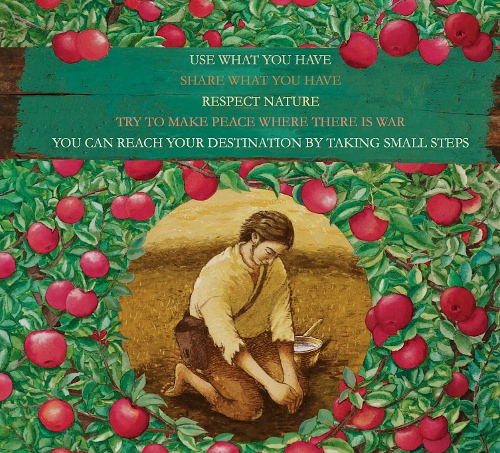
A portion of the back jacket illustration from Seed by Seed
(Click to enlarge)
This morning over at Kirkus, I write about David Ezra Stein’s Because Amelia Smiled. Ah. So good. Go read it and smile. (That link will be here.)
* * *
Last week, I wrote about Esmé Raji Codell’s Seed by Seed: The Legend and Legacy of John “Appleseed” Chapman, illustrated by Lynne Rae Perkins. That link is here.
Today is a bit more art from the book.
Enjoy. (more…)
 This morning over in Kirkus’ Book Blog Network, I chat with author Lauren Thompson, pictured here, about her latest picture book.
This morning over in Kirkus’ Book Blog Network, I chat with author Lauren Thompson, pictured here, about her latest picture book.
Lauren has written many picture books over the years that I’ve enjoyed — and shared with my own children. Her forthcoming book is called The Forgiveness Garden, and it’s illustrated by Christy Hale.
The Q&A will be here this morning, and next week here at 7-Imp I’ll follow up with a few more questions and responses from Lauren, as well as some more art from Christy.
Enjoy.
* * * * * * *
Photo credit: Carol Stevens.
“Don’t use art notes,” is what you may hear as a new writer.
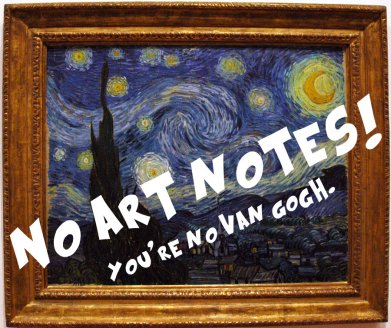
It’s not that editors don’t like art notes. It’s just that many new writers want to dictate illustrations that do not require direction.
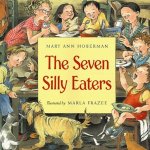 For instance, you shouldn’t pick what your character looks like. Red hair, blue shirt, green sneakers, pigtails, etc. are not for you to decide. The editor of Mary Ann Hoberman’s THE SEVEN SILLY EATERS thought the characters should be animals, like crocodiles. Marla Frazee, the illustrator, thought they should be people, and she was right. She even made the mother a cello player, which was not in the text, but it added a delightful layer to the mother’s personality. The options were wide open—the author never described the characters’ appearance.
For instance, you shouldn’t pick what your character looks like. Red hair, blue shirt, green sneakers, pigtails, etc. are not for you to decide. The editor of Mary Ann Hoberman’s THE SEVEN SILLY EATERS thought the characters should be animals, like crocodiles. Marla Frazee, the illustrator, thought they should be people, and she was right. She even made the mother a cello player, which was not in the text, but it added a delightful layer to the mother’s personality. The options were wide open—the author never described the characters’ appearance.
 The exception to this rule is when your character’s appearance is crucial to the story, like FRECKLEFACE STRAWBERRY. Although the title pretty much says it all, right?
The exception to this rule is when your character’s appearance is crucial to the story, like FRECKLEFACE STRAWBERRY. Although the title pretty much says it all, right?
You must trust that your editor and illustrator have ideas for what your scenes should look like. Better ideas than you. Leave the art direction to them (and the art director). Writing that the house has a front porch, or that the cat is calico, or that the car is yellow is all unnecessary. Again, unless that car needs to be yellow for your story to work.
But you will no doubt read picture books with subversive text—where the character is doing completely opposite what the words say. Or books with text so spare, the action comes thru only in illustration. These are times when your text requires art notes. SCREAMS for them.
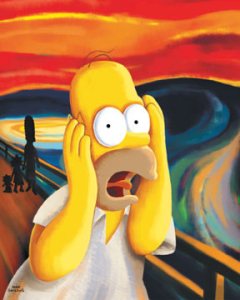
But if you have an art-heavy manuscript, where much of the story relies upon the illustrations, how do you submit it? Putting the art notes in [brackets and italics] is typically the way to go. However, too many art notes can interrupt the flow of the story. It gets difficult to read and comprehend.
So what do you do?
Maybe…submit your manuscript in grid format.
What?! But Tara, I’ve NEVER heard of this before.
I know, me neither. But my agent just submitted a manuscript like this. I was skeptical at first, but then I realized the grid was the best no-nonsense way to present the text with the illustrative mayhem. Yes, this book has MAYHEM. And FRACAS and PANDEMONIUM, too.
Here’s what the grid looks like in manuscript format:

The header includes your name, contact details and a word count.
Then the title (in caps) and your byline.
There is a general art note at top which introduces the story idea. Moreover, it states the art notes are “intended as a guideline.” Again, as an author, you cannot rule over all that is picture in picture books.
Next comes the grid. On the left is the story text, on the right appears “rough art direction.” Notice we said “rough” because they are only suggestions for the editor to understand the story. Remember that the illustrator may create something even better, funnier, more poignant. Remember the CELLO.
The grid continues for as long as it takes to tell your story. Typically one or two more manuscript pages.
Please note this isn’t a standard way to submit, it only serves as an example of what one author and her agent did. It’s like the photos on the front of frozen food boxes that say “serving suggestion”.

Now if you’ll excuse me, I suddenly became very hungry.


Book: This Is Not My Hat
Author: Jon Klassen (@burstofbeaden)
Pages: 40
Age Range: 3 and up

 This Is Not My Hat is a companion book to Jon Klassen's I Want My Hat Back. I wouldn't call it a sequel, because the characters are different, but the storyline is similar. A small fish is swimming along and admits "This is not my hat." We learn that the small fish stole the hat from a big fish. But he's not worried, because the big fish probably won't even notice, and even if he does, he won't be able to find the small fish. Right? But even as we see the small fish's brave words, we also see the reactions of the big fish. Muted but clear, as he turns his eye upward to note his empty head, and then narrows his eye in annoyance, as he steams forward to look for the hat. The end, well, the end will not come as a surprise to those who read the first book.
This Is Not My Hat is a companion book to Jon Klassen's I Want My Hat Back. I wouldn't call it a sequel, because the characters are different, but the storyline is similar. A small fish is swimming along and admits "This is not my hat." We learn that the small fish stole the hat from a big fish. But he's not worried, because the big fish probably won't even notice, and even if he does, he won't be able to find the small fish. Right? But even as we see the small fish's brave words, we also see the reactions of the big fish. Muted but clear, as he turns his eye upward to note his empty head, and then narrows his eye in annoyance, as he steams forward to look for the hat. The end, well, the end will not come as a surprise to those who read the first book.
I think that having read (and loved) the first book does take away from this one, a little. It's pretty clear all along that the small fish is not going to succeed in his quest to keep the hat. But that's part of the humor of This Is Not My Hat, too. Reading the confident words of the small fish, but seeing in the illustrations how misguided he is. I'm not sure that my two-year-old is mature enough to appreciate the humor, but I think that This Is Not My Hat will have four-year-olds rolling on the floor with laughter.
Klassen has a real flair for getting emotions across with minimal illustrations (and minimal text, for that matter). Four illustrations in a row differ only in the big fish's eyes, and the bubbles coming from his mouth. But this is enough to tell a whole story. I think the funniest page is one in which the text reads "So I am not worried about that" (in reference to anyone telling the big fish where the small fish went), above a picture of a wide-eyed lobster pointing the way for the angry big fish. I challenge anyone not to let out a little snort of laughter.
This Is Not My Hat is a must-add title for libraries, and for households where I Want My Hat Back was a hit. Highly recommended.
Publisher: Candlewick (@Candlewick)
Publication Date: October 9, 2012
Source of Book: Finished review copy from the publisher
© 2012 by Jennifer Robinson of Jen Robinson's Book Page. All rights reserved. This site is an Amazon affiliate, and purchases made through Amazon links may result in my receiving a small commission (at no additional cost to you).
 After reading this book, I had to chuckle to think about my own (of course, very limited) time spent in the corner being punished. In Time Out for Monsters!, the little boy has been sent to the corner most certainly to think about what he has done wrong. Instead he starts deciding what he would do to “spruce up” the corner where he spends so much time. He thinks it could definitely use some color and a window, oh, and some flowers, and what about a dinosaur or two or three. Of course the corner needs a monster and a monster truck and what about a fire truck! (You can see where this is going.) How about a dump truck full of ice cream or maybe a dragon? When all of these wonderful ideas end up as pictures colored on the living room wall, you just know there will lots more opportunities to “think” and decorate in the corner. Very clever and fun!
After reading this book, I had to chuckle to think about my own (of course, very limited) time spent in the corner being punished. In Time Out for Monsters!, the little boy has been sent to the corner most certainly to think about what he has done wrong. Instead he starts deciding what he would do to “spruce up” the corner where he spends so much time. He thinks it could definitely use some color and a window, oh, and some flowers, and what about a dinosaur or two or three. Of course the corner needs a monster and a monster truck and what about a fire truck! (You can see where this is going.) How about a dump truck full of ice cream or maybe a dragon? When all of these wonderful ideas end up as pictures colored on the living room wall, you just know there will lots more opportunities to “think” and decorate in the corner. Very clever and fun!
Posted by: Mary


View Next 25 Posts

















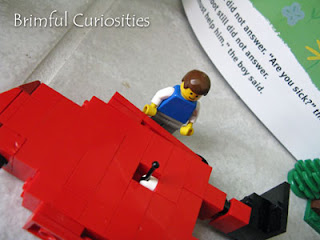









 Then click on the hashtag to see what other parents and caregivers are reading.
Then click on the hashtag to see what other parents and caregivers are reading.






 Ibrahima Ndiaye, illustrated by Capucine Mazille, translated by Rebecca Page,
Ibrahima Ndiaye, illustrated by Capucine Mazille, translated by Rebecca Page,
 This morning over in Kirkus’ Book Blog Network, I chat with author
This morning over in Kirkus’ Book Blog Network, I chat with author 
 For instance, you shouldn’t pick what your character looks like. Red hair, blue shirt, green sneakers, pigtails, etc. are not for you to decide. The editor of Mary Ann Hoberman’s THE SEVEN SILLY EATERS thought the characters should be animals, like crocodiles. Marla Frazee, the illustrator, thought they should be people, and she was right. She even made the mother a cello player, which was not in the text, but it added a delightful layer to the mother’s personality. The options were wide open—the author never described the characters’ appearance.
For instance, you shouldn’t pick what your character looks like. Red hair, blue shirt, green sneakers, pigtails, etc. are not for you to decide. The editor of Mary Ann Hoberman’s THE SEVEN SILLY EATERS thought the characters should be animals, like crocodiles. Marla Frazee, the illustrator, thought they should be people, and she was right. She even made the mother a cello player, which was not in the text, but it added a delightful layer to the mother’s personality. The options were wide open—the author never described the characters’ appearance. The exception to this rule is when your character’s appearance is crucial to the story, like FRECKLEFACE STRAWBERRY. Although the title pretty much says it all, right?
The exception to this rule is when your character’s appearance is crucial to the story, like FRECKLEFACE STRAWBERRY. Although the title pretty much says it all, right?



 After reading this book, I had to chuckle to think about my own (of course, very limited) time spent in the corner being punished. In Time Out for Monsters!, the little boy has been sent to the corner most certainly to think about what he has done wrong. Instead he starts deciding what he would do to “spruce up” the corner where he spends so much time. He thinks it could definitely use some color and a window, oh, and some flowers, and what about a dinosaur or two or three. Of course the corner needs a monster and a monster truck and what about a fire truck! (You can see where this is going.) How about a dump truck full of ice cream or maybe a dragon? When all of these wonderful ideas end up as pictures colored on the living room wall, you just know there will lots more opportunities to “think” and decorate in the corner. Very clever and fun!
After reading this book, I had to chuckle to think about my own (of course, very limited) time spent in the corner being punished. In Time Out for Monsters!, the little boy has been sent to the corner most certainly to think about what he has done wrong. Instead he starts deciding what he would do to “spruce up” the corner where he spends so much time. He thinks it could definitely use some color and a window, oh, and some flowers, and what about a dinosaur or two or three. Of course the corner needs a monster and a monster truck and what about a fire truck! (You can see where this is going.) How about a dump truck full of ice cream or maybe a dragon? When all of these wonderful ideas end up as pictures colored on the living room wall, you just know there will lots more opportunities to “think” and decorate in the corner. Very clever and fun!
I was at a workshop earlier this week for speech-language pathologists and the professor, Gail Richard, Ph.D., was discussing how the brain develops in order to be ready for reading. She said that although some kids read precociously at age 3, that doesn't mean they understand what they are reading. She said the brains of most kids aren't ready until age 7, but sometimes much later (as late as age 10) and that to force kids to read before they are ready is not helpful.
So long live the picture book!
To forgo the rich vocabulary, the rhythms, and the work of the picture and text together in order to "advance" a child is a very sad thing.
I love picture books and they are for everyone at any age. My kids -- 12, 10 and 7 -- still read picture books! The art itself is worthy of the book purchase in some picture books. It's also a complete story in 36 pages. The parents who think those repetitive chapter books are "more advanced" and "better" than picture books are completely misguided. Also, there are such great advanced picture books that have reading difficulty levels of chapter books. One Morning in Maine is one example. Mirette and any book by Patricia Polacco or Emily Arnold McCully.
Agreed and agreed. There are a number of picture books I used in my middle school classrooms. And when you think of it from strictly an art perspective, it's a very inexpensive purchase you can enjoy again and again.
You are so right about a picture book being an inexpensive piece of art. I've often thought that.
And Carolee's thought about kids learning to read later . . . so true. That happened with my middle child who knew the alphabet, devoured books, could sound out words, but would NOT read on his own and had no fluency. It finally kicked in when he was 9 years old - and he practically gave me heart failure with worry. But he jumped from three letter word stories to reading Jurassic Park in about 6 months. It was mind-boggling. There are a certain percentage of kids who do this and I'm so glad I was homeschooling him at the time because I fear he would have ended up in Special Ed - where I knew he didn't need to be. He's now my biggest reader of all three boys.